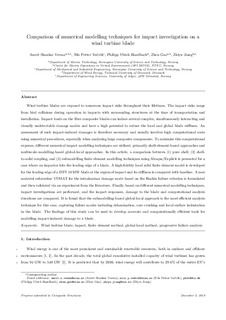| dc.contributor.author | Verma, Amrit Shankar | |
| dc.contributor.author | Vedvik, Nils Petter | |
| dc.contributor.author | Haselbach, Philipp Ulrich | |
| dc.contributor.author | Gao, Zhen | |
| dc.contributor.author | Jiang, Zhiyu | |
| dc.date.accessioned | 2019-02-21T14:28:15Z | |
| dc.date.available | 2019-02-21T14:28:15Z | |
| dc.date.created | 2018-11-17T11:16:10Z | |
| dc.date.issued | 2019 | |
| dc.identifier.citation | Composite structures. 2019, 209 (C), 856-878. | nb_NO |
| dc.identifier.issn | 0263-8223 | |
| dc.identifier.uri | http://hdl.handle.net/11250/2586842 | |
| dc.description.abstract | Wind turbine blades are exposed to numerous impact risks throughout their lifetimes. The impact risks range from bird collisions during operation to impacts with surrounding structures at the time of transportation and installation. Impact loads on the fibre composite blades can induce several complex, simultaneously interacting and visually undetectable damage modes and have a high potential to reduce the local and global blade stiffness. An assessment of such impact-induced damages is therefore necessary and usually involves high computational costs using numerical procedures, especially when analysing large composite components. To minimise this computational expense, different numerical impact modelling techniques are utilised, primarily shell-element-based approaches and multiscale-modelling-based global-local approaches. In this article, a comparison between (1) pure shell, (2) shell-to-solid coupling, and (3) submodelling finite element modelling techniques using Abaqus/Explicit is presented for a case where an impactor hits the leading edge of a blade. A high-fidelity local solid finite element model is developed for the leading edge of a DTU 10 MW blade at the region of impact and its stiffness is compared with baseline. A user material subroutine VUMAT for the intralaminar damage mode based on the Hashin failure criterion is formulated and then validated via an experiment from the literature. Finally, based on different numerical modelling techniques, impact investigations are performed, and the impact responses, damage to the blade and computational analysis durations are compared. It is found that the submodelling-based global-local approach is the most efficient analysis technique for this case, capturing failure modes including delamination, core crushing and local surface indentation in the blade. The findings of this study can be used to develop accurate and computationally efficient tools for modelling impact-induced damage to a blade. | nb_NO |
| dc.language.iso | eng | nb_NO |
| dc.publisher | Elsevier | nb_NO |
| dc.rights | Attribution-NonCommercial-NoDerivatives 4.0 Internasjonal | * |
| dc.rights.uri | http://creativecommons.org/licenses/by-nc-nd/4.0/deed.no | * |
| dc.title | Comparison of numerical modelling techniques for impact investigation on a wind turbine blade | nb_NO |
| dc.type | Journal article | nb_NO |
| dc.type | Peer reviewed | nb_NO |
| dc.description.version | acceptedVersion | nb_NO |
| dc.source.pagenumber | 856-878 | nb_NO |
| dc.source.volume | 209 | nb_NO |
| dc.source.journal | Composite structures | nb_NO |
| dc.source.issue | C | nb_NO |
| dc.identifier.doi | 10.1016/j.compstruct.2018.11.001 | |
| dc.identifier.cristin | 1631651 | |
| dc.relation.project | Norges forskningsråd: 237929 | nb_NO |
| dc.description.localcode | © 2018. This is the authors’ accepted and refereed manuscript to the article. Locked until 10.11.2020 due to copyright restrictions. This manuscript version is made available under the CC-BY-NC-ND 4.0 license http://creativecommons.org/licenses/by-nc-nd/4.0/ | nb_NO |
| cristin.unitcode | 194,64,20,0 | |
| cristin.unitcode | 194,64,92,0 | |
| cristin.unitname | Institutt for marin teknikk | |
| cristin.unitname | Institutt for maskinteknikk og produksjon | |
| cristin.ispublished | true | |
| cristin.fulltext | postprint | |
| cristin.qualitycode | 1 | |

